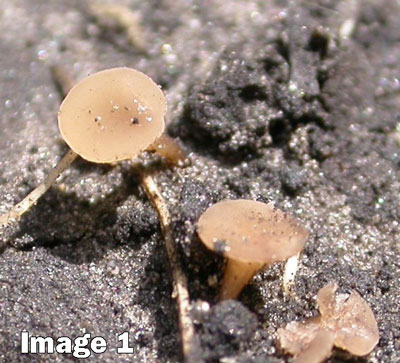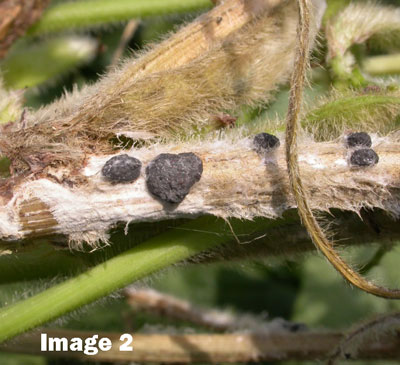
- White mold (Sclerotinia stem rot) is an important fungal disease in soybeans and is favored by cool, wet weather during flowering.
- Signs of white mold show up at growth stages R5/R6, and include fuzzy white mycelium on stems and pods, with embedded black sclerotia (hardened structures).
- Management of white mold requires an integrated approach involving cultural, mechanical, biological, and chemical control measures.
- Chemical prevention is achieved by two applications of specific foliar fungicides at R1 and R3 growth stages to protect flowers from infection.
- A biological soil treatment known as Coniothyrium minitans may help degrade sclerotia in the soil.
Biology and Life Cycle
White mold (also known as Sclerotinia stem rot) is an important fungal disease in soybeans. Infection is favored by cool, wet weather during flowering, so the disease is typically a concern in more northerly climates.
The life cycle of white mold is complex and involves several stages. Small hardened black structures called sclerotia germinate in the top 2 inches of the soil into very small mushroom-like reproductive structures called apothecia. The apothecia appear on the soil surface in response to cool, wet conditions during the early flowering stage of soybeans (see Image 1). The apothecia release ascospores that infect the soybean flowers, so the soybean plant is most vulnerable to infection during growth stages R1 through R3. If cool and wet conditions persist later into the season, the infection progresses and eventually produces the characteristic sign of white cottony fuzzy mycelium growth on the stem and pods, giving rise to the name of "white mold". The white cottony growth is embedded with sclerotia, the hardened black overwintering structures that resemble rat dung (see Image 2). The sclerotia fall to the ground after harvest and repeat the cycle under favorable conditions.

Crop Injury
White mold causes yield loss by reduced seed number and size. Yield is reduced approximately 2-5 bu per every 10% increase in incidence at growth stage R7. Severe infections can lead to wilt, lodging, and premature death of the plant (See image 3).
Management
Management of white mold should take an integrated approach, including cultural, mechanical, biological, and chemical control methods. Chemical control methods alone typically do not provide effective management.
The disease is favored by cultural practices that reduce air movement and increase humidity in the canopy, including high populations, narrow row spacing, high soil fertility, and rapid canopy closure. Many of these same cultural practices may represent a tradeoff for effective management of problem weeds, like waterhemp. Select certified pathogen-free varieties that are adapted to your local climate, with the best available resistance to white mold. Use extended crop rotations of 2-3 years without soybeans and non-host crops (corn, wheat, barley, oats). Alfalfa and clover, as well as many winter annuals, serve as alternate hosts.
Chemical control involves the use of foliar fungicides applied at R1 and R3. Not all foliar fungicides are effective on white mold. Please refer to the document Fungicide Efficacy for the Control of Soybean Foliar Diseases for product efficacy ratings on white mold. Wisconsin researchers achieved effective control by using Endura DF (BASF) at R1 or a dual application of Aproach (DuPont) at both R1 and R3. Other products are also labeled for suppression or control. Applications made after symptoms or signs appear are too late to be effective.
Herbicides containing lactofen may offer some level of control by manipulating the growth and development of the soybean plant or by inducing systemic acquired resistance (SAR).

Contans (Coniothyrium minitans) is a bacterial biological control agent applied to the soil to degrade sclerotia before they can germinate. C. minitans must be applied 3 months before sclerotia start germinating to provide adequate time for the bacteria to infect and degrade sclerotia. The product should be incorporated in the top 2 inches and then the soil should be left undisturbed through the next harvest. Avoiding tillage after the product has been incorporated prevents diluting the product deeper into the soil and avoids bringing fresh sclerotia to the soil surface. Research in crops other than soybeans suggests 95% efficacy in reducing sclerotia and results ranging from 10-70% reduction in white mold infection. The product should not be relied upon as a standalone control measure.
Contact your FS Crop Specialist for your agronomic information.
Image 1: Apothecia on soil surface. (Source: GROWMARK, Inc.)
Image 2: White mycelium and black sclerotia on soybean stem. (Source: GROWMARK, Inc.)
Image 3: White mold symptoms in a soybean field. (Source: GROWMARK, Inc.)